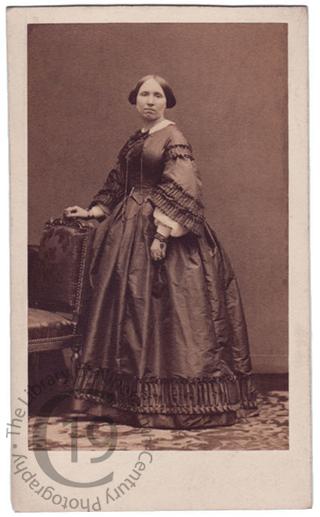
Mme Célestine Emarot
Born Marguerite Adélaïde Emarot into a family originating in Dijon, her mother was employed in the linen trade but moved to Paris about 1834 to seek a better life. Some two or three years later, through the influence of friends, Marguerite was admitted to the Opéra dancing school, adopting the name Célestine. She soon became the mistress of the Baron Charles de Chassiron, a member of the Jockey Club who spent much of his time in the Foyer de la Danse. There is some confusion as to the actual date, but probably in 1842 she gave birth to a daughter, who was baptized more than a year later, on 14 December 1843, at the church of Notre-Dame de Lorette, and given the names Emma Marie.
Célestine Emarot made her début as a sujet on 11 August 1845, when she created the role of Yelva in Le Diable à quatre. Although her performance was manifestly painstaking, her talent was considered mediocre and few found her dancing pleasing. She filled secondary roles adequately enough, but failed miserably when called upon to take an important part, such as the Abbess in Robert le Diable; many gentleman whose memories of Taglioni were still vivid could not bear to watch her in the role and retired to the Foyer, while laughter was heard from the pit.
Baron de Chassiron soon tired of his mistress and his daughter, and in 1850 married Princess Caroline Murat, a cousin of the Emperor, whom he abandoned in turn a few years later to embark on a long voyage through Asia. Célestine Emarot’s earnings as a dancer never exceeded 6,000 francs a year, but she probably received an allowance from Chassiron or some other protector, for she was able to give her daughter a good education, sending her to a respectable girls’ school in the Faubourg-Poissonière.
The fickle Chassiron was eventually replaced in Mme. Emarot’s affections by another nobleman, the Vicomte Ferdinand de Montguyon. One of the original members of the Jockey Club and a hardened gambler, his ugly, painted face was a familiar sight backstage at the Opéra. His powerful friends included the Emperor’s half-brother, making him a man to be reckoned with. Emma could not have had a better champion and his representations on her behalf resulted in the decision that she should only make her début when able to bear the responsibility of a principal role.
Mme. Emarot chaperoned her daughter throughout her short career, accompanying her to every rehearsal and performance. She was present on the occasion of her tragic accident and she nursed her through the long, pain-filled months that followed. At Emma’s death, her mother was plunged into inconsolable grief. When Montguyon learned that she had had to pawn her jewellery to meet the heavy medical expenses incurred, he saw to it that her plight was brought to the attention of the Emperor, who at once granted her a gratuity of 40,000 francs and a pension of 6,000 francs a year. However, after the fall of the Second Empire, the new government refused to recognize many of the pensions granted out of the Emperor’s Civil List, Mme. Emarot’s among them. She retired to a modest apartment at 19, Avenue de la Grande Armée, where she died on 7 October 1892, at the age of sixty-eight. She had outlived her daughter by nearly thirty years.
[The above biography is adapted from the first chapter of Ivor Guest’s The Ballet of the Second Empire: 1858-1870, London, 1953.]
Photographed by A. A. E. Disdéri.
Code: 122073




